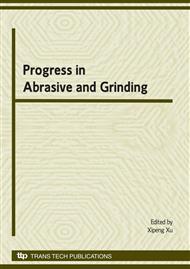p.123
p.131
p.137
p.143
p.149
p.157
p.165
p.177
p.185
Effect of Slurry and Nozzle on Hole Machining of Glass by Micro Abrasive Suspension Jets
Abstract:
Micro drilling experiments of glass by Micro Abrasive Suspension Jets (MASJ) were carried out. The influence of the nozzle and compositions of slurry including the selection of abrasives, suspending agents and their concentrations on material removal, the depth and the diameter of the machined holes were investigated for glass drilling. Four processing stages are provided to describe the erosion profile characteristics. The suspension properties of slurry play an important role in MASJ machining. Five million molecular weight non-ionic polyacrylamide with concentration of 0.6% , white corundum abrasive and the longest length of the nozzle cylindercal zone can achieve lager material removal and better quality of hole in MASJ machining.
Info:
Periodical:
Pages:
177-183
Citation:
Online since:
January 2009
Authors:
Keywords:
Price:
Сopyright:
© 2009 Trans Tech Publications Ltd. All Rights Reserved
Share:
Citation:


